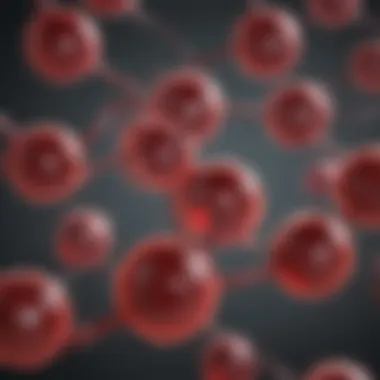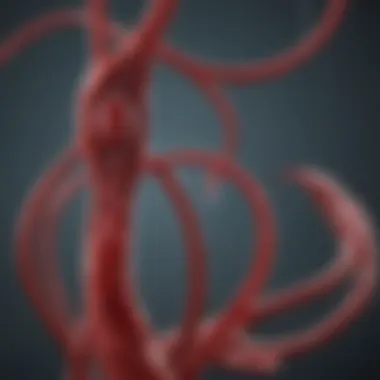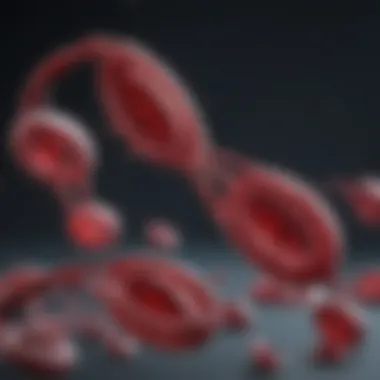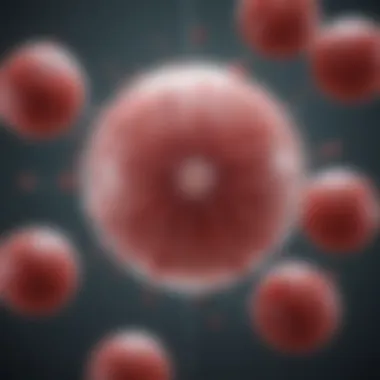Exploring Curative Approaches for Sickle Cell Disease


Intro
Sickle cell disease (SCD) poses significant challenges not only to those ailing from it but also to the medical community attempting to manage its diverse complexities. The condition finds its roots in genetic mutations, specifically in the hemoglobin gene, resulting in the production of abnormally shaped red blood cells. As these cells assume a crescent or sickle shape, they lose their flexibility and tend to aggregate, leading to various complications that disrupt the flow of blood and oxygen throughout the body.
In light of the ongoing research efforts, this article examines the potential for curative solutions for sickle cell disease. We delve into an array of recent advancements, including the groundbreaking field of genetic modifications and innovative treatments such as gene therapy and hematopoietic stem cell transplantation. Each of these approaches holds the promise of fundamentally altering the trajectory of SCD management.
Recent Advances
Latest Discoveries
Recent discoveries in the realm of genetic therapies have illuminated promising pathways toward curing sickle cell disease. In particular, CRISPR-Cas9 technology has emerged as a game-changer. This revolutionary gene-editing tool allows scientists to modify specific genetic sequences with unprecedented precision. For instance, researchers have embarked on clinical trials utilizing CRISPR to directly correct the mutation responsible for sickle cell disease. The results from initial studies indicate significant improvements in hemoglobin production, offering hope for a functional cure.
Moreover, improved understanding of the role of fetal hemoglobin suggests potential avenues for treatment. Fetal hemoglobin, a type of hemoglobin present in newborns, differs from adult hemoglobin and is less susceptible to the sickling process. Emerging drugs like Hydroxyurea aim to induce the production of fetal hemoglobin in patients, providing a management strategy that alleviates symptoms and reduces the frequency of painful crises.
Technological Innovations
Technological advancements further complement novel medical therapies. Genetic monitoring technologies are evolving, enabling doctors to better understand and track the specific genetic profiles of patients with SCD. Personalized medicine, tailored to the unique genetic make-up of individuals, is on the horizon.
In addition, the advent of telemedicine and wearable health devices has revolutionized patient monitoring, providing real-time data on vital health parameters. Such innovations ensure timely interventions, allowing healthcare providers to respond swiftly to complications that may arise in sickle cell patients.
*"The integration of technology in medicine is not just a trend; it’s the pathway to rethinking treatment paradigms and patient care."
Methodology
Research Design
The methodology for exploring a cure for sickle cell disease involves a multi-faceted approach that combines laboratory research, clinical trials, and observational studies. Various research teams collaborate globally, pooling their insights and data to further the understanding of the genetic basis of SCD and the effectiveness of emerging therapies.
Data Collection Techniques
Data collection is carried out using a variety of techniques. Clinical trials, for instance, utilize controlled environments to compare existing treatments with experimental interventions. Patient registries and prolonged observational studies also contribute valuable data on long-term outcomes associated with different therapies, enhancing our understanding of treatment efficacy and patient experiences.
Understanding the breadth and depth of these methodologies is crucial for grasping the complexities surrounding the quest for a cure. It ensures that stakeholders—from researchers to healthcare providers—can make informed decisions in the ever-evolving landscape of sickle cell disease treatment.
Understanding Sickle Cell Disease
Sickle cell disease (SCD) is not just a medical condition; it's a multifaceted challenge entwined with genetics, biology, and socio-economic factors. Understanding the underpinnings of this disease is crucial, as it lays the groundwork for exploring potential cures. The disease’s genetic basis and its manifestations in affected individuals provide insights into effective treatment modalities.
By studying SCD, we can identify specific characteristics that influence outcomes and shape the future of research. For instance, recognizing the genetic mutations involved opens avenues for novel gene therapies. Addressing SCD involves a collaboration of biology and social aspects, as numerous ethnic groups are affected, each experiencing different rates of prevalence and access to care. Such insights drive home why grappling with SCD is paramount for both medical science and public health.
The Genetics of Sickle Cell Disease
Genetic mutations involved
The core of sickle cell disease lies in a specific mutation in the hemoglobin-beta gene. This mutation, found on chromosome 11, results in the production of hemoglobin S. Understanding this single point mutation is essential. It determining whether someone inherits the disease or remains merely a carrier. Notably, the presence of valine instead of glutamic acid influences the physical properties of red blood cells, causing them to deform under low oxygen conditions. This mutation's role is pivotal as it leads to the disease's hallmark symptoms and is a focal point in current therapeutic approaches.
Mode of inheritance
Sickle cell disease follows an autosomal recessive pattern of inheritance. This means that for an individual to manifest the disease, they must inherit two copies of the defective gene—one from each parent. This genetic arrangement is pivotal in understanding potential interventions, as screening for carriers becomes a vital public health strategy. Awareness of this mode of inheritance can empower families and communities through genetic counseling and informed reproductive choices, impacting disease prevalence in future generations.
Ethnic prevalence
Ethnic prevalence paints a vivid picture of sickle cell disease’s impact globally. The disease primarily affects individuals of African, Mediterranean, Middle Eastern, and Indian descent. Understanding this aspect highlights cultural and geographical dimensions that influence research funding, treatment availability, and public health policies. The unique prevalence among these populations emphasizes the need for tailored healthcare strategies, ensuring they meet the specific needs of those affected.
Pathophysiology of SCD
Mechanisms of red cell sickling
The mechanics of red cell sickling present a complex scenario underlying the clinical manifestations of SCD. When oxygen levels drop, hemoglobin S molecules begin to polymerize, leading to the characteristic sickle shape of the red blood cells. This not only halts their ability to carry oxygen efficiently but also causes these cells to become rigid, leading to blockages in small blood vessels. Such insights gleaned from understanding these mechanisms are vital for developing treatments that can prevent sickling or improve blood flow, providing potential avenues for therapeutic inventions.
Complications associated with SCD
Sickle cell disease comes with a host of complications, from pain crises to vascular problems. The nature of the disease impacts multiple organ systems, inducing conditions such as acute chest syndrome and stroke. Targeting these complications becomes crucial in managing the overall disease burden. Recognizing which complications are most prevalent also informs strategies to improve patient outcomes through preventive measures and tailored interventions.
Impact on organ systems


The impact of SCD extends far beyond the blood. It particularly affects organs like the spleen, kidneys, and the brain. The sickling phenomenon, coupled with chronic hemolysis, leads to a myriad of organ-specific complications. For instance, splenic dysfunction—a common complication—enhances susceptibility to infections, particularly in young children. Addressing the systemic implications of sickle cell disease can help refine therapeutic strategies aimed at protecting organ function and enhancing longevity for patients.
Current Treatments for Sickle Cell Disease
Understanding the landscape of treatments available for sickle cell disease (SCD) is crucial in grasping how patients can manage symptoms and improve their lives amid the challenges posed by the condition. Current treatments are not aimed solely at curing the disease but rather at alleviating its symptoms, preventing complications, and maintaining a better quality of life. In this section, we will look at pain management strategies as well as preventive measures that can aid in regulating symptoms of the disease.
Pain Management Strategies
Living with sickle cell disease often means grappling with pain that can flare up unpredictably. Managing this pain effectively is fundamental to enabling individuals to lead more fulfilling lives.
Pharmacologic treatments
Pharmacologic treatments remain a cornerstone in pain management for individuals with SCD. They include opioids and non-steroidal anti-inflammatory drugs (NSAIDs), designed to alleviate acute pain episodes. The key characteristic of pharmacologic treatments is their ability to quickly provide relief during painful crises. For many patients, these medications are a necessary choice; they offer significant comfort during attacks.
Nevertheless, reliance on these drugs carries its own set of challenges. There are risks of dependency with long-term use and potential side effects such as constipation and nausea. Also, the variability in individual responses to pain medications means what works for one patient might not be effective for another, adding another layer of complexity to pain management strategies.
Non-pharmacologic approaches
In tandem with pharmacologic treatments, many individuals turn to non-pharmacologic approaches for pain management. These can range from physical therapy and acupuncture to relaxation techniques such as mindfulness and breathing exercises. The unique feature of these approaches is their holistic nature; they aim not just at pain relief but also at improving overall well-being.
The benefits of non-pharmacologic methods include fewer side effects and addressing underlying stress factors that might contribute to pain. However, it’s important to recognize that non-pharmacologic strategies work best when used alongside pharmaceuticals, forming a complementary relationship rather than a stand-alone solution.
Challenges in pain management
Despite the array of strategies available for pain management, several challenges persist. Dosage calibrations, patient compliance, and the effectiveness of various treatments can vary widely among individuals, thus complicating the management landscape. Additionally, there exists a stigma surrounding the use of opioids, which can deter some patients from seeking adequate relief for their pain.
Effective pain management is essential for patients with sickle cell disease, but the journey is often riddled with obstacles.
Preventive Measures
Preventive measures play an indispensable role in the management of sickle cell disease, as they can lessen the frequency of painful crises and associated complications.
Vaccinations and prophylactic antibiotics
Vaccinations are a crucial aspect of preventive care for patients with SCD. Individuals with this condition are at a higher risk for infections; thus, timely vaccinations protect them against severe illness. This is especially true for vaccines like pneumococcal and meningococcal vaccines.
The key characteristic of these preventive measures is their ability to preemptively shield patients from infections. Ensuring that patients are up-to-date on vaccinations is an effective choice and can significantly reduce hospitalization rates.
However, there are potential downsides. Some patients may have extreme fear of needles or possible allergic reactions, which could deter them from getting vaccinated. Consistent education and support can help alleviate these fears.
Folic acid supplementation
Folic acid supplementation is another preventive measure that can aid in managing sickle cell disease. This vitamin is crucial for the production of red blood cells, and individuals with SCD often benefit from its supplementation. The key characteristic of folic acid is that it supports the body’s ability to produce healthy red blood cells, which can be hindered due to the disease.
This preventive measure is straightforward and generally safe, making it a popular choice. Yet, while folic acid supplementation may mitigate some complications, it is not a standalone solution and should be part of a comprehensive treatment plan.
Hydroxyurea therapy
Hydroxyurea therapy appears as a beacon of hope among preventive measures. It works by encouraging the body to make fetal hemoglobin, which can reduce the incidence of painful sickle cell crises. Its unique feature lies in its role as both a pain reducer and a preventive tool that can decrease complications associated with the disease.
The key characteristic of hydroxyurea is its dual action of both treating and preventing severe episodes of SCD. While it has shown to be effective, some patients may encounter side effects like low blood counts, necessitating careful monitoring. Furthermore, not all patients respond favorably to this therapy, requiring personalized management approaches to optimize effectiveness.
Curative Approaches: An Overview
The exploration of curative approaches for sickle cell disease (SCD) is a beacon of hope in the realm of hematology. Unlike traditional symptom management, these approaches aim to fundamentally alter the disease's trajectory. By diving into innovative strategies such as hematopoietic stem cell transplantation and gene therapy, this article sheds light on potential pathways to a cure.
The importance of these curative methods lies in their potential to not just alleviate symptoms, but to address the underlying genetic causes of SCD. This holistic approach presents a promise that could transform lives and drastically improve the quality of life for patients.
Hematopoietic Stem Cell Transplantation
Hematopoietic stem cell transplantation (HSCT) operates on the principle of replacing a patient’s defective blood cell production system with healthy cells from a donor.
Indications for transplant
The main indications for HSCT pivot around severe cases of SCD where the risks associated with the disease outweigh the risks of undergoing such a rigorous procedure. It's seen as a beneficial choice for patients with recurrent crises or organ damage due to recurrent sickling episodes. The unique feature that stands out here is the ability to provide a potential "cure" for individuals with specific genetic markers compatible with HSCT. One downside, however, is the limited number of suitable candidates due to the nature of donor compatibility.
Donor matching and selection


Ensuring the right donor match can be a pivotal point in the success of HSCT. Donor matching is based on human leukocyte antigen (HLA) typing. The key characteristic of this process is its complexity; a perfect match is ideal, but often hard to find. It is a beneficial approach because it increases the chances of successful engraftment and minimizes the risk of complications associated with transplant. The unique feature here includes the availability of matching registries, though this also comes with the disadvantage of time sensitivity in finding a match, which can delay treatment.
Risks and outcomes
The risks associated with HSCT can range from graft-versus-host disease to infections due to immunosuppression. Understanding these risks is critical as it forms the backbone of informed decision-making for patients and healthcare providers. The key characteristic of outcomes can vary significantly; while some patients achieve full remission, others may suffer from complications. As a beneficial POV, the survival rates have improved over the years, showcasing advances in pre-transplant conditioning and post-transplant care. Yet, the unique aspect of these outcomes brings with it the challenge that not all patients will receive complete relief from symptoms after the procedure.
Gene Therapy Innovations
In recent years, gene editing technologies, particularly CRISPR, have emerged at the forefront of potential cures for genetic disorders like SCD. This section unpacks how such innovations could revolutionize the treatment landscape.
CRISPR and gene editing technologies
CRISPR's role in gene editing essentially allows scientists to make precise changes in the DNA. This specific aspect is groundbreaking because it can potentially correct the faulty gene responsible for SCD. The key characteristic of this technology lies in its ability to target specific sequences within the genome. The beneficial potential is immense, as it requires less invasive techniques than traditional methods, and could be available for a wider patient population. However, the unique challenge is the ethical concerns and the long-term effects of editing human genes, which remain a significant gray area in current medicine.
Clinical trials and findings
Clinical trials are crucial in evaluating the effectiveness of gene therapies. These trials gauge both safety and efficacy while exploring new avenues in treating SCD. The key characteristic of these trials is their rigorous design, often taking years to yield conclusive results. They provide invaluable data that validate the applicability of these innovations to real-world settings. However, patient participation often hinges on complex eligibility criteria, which can be a disadvantage, excluding many individuals who might benefit from these therapies.
Future directions in gene therapy
Looking forward, the future of gene therapy in the context of SCD holds immense promise. Emerging research indicates that there may be ways to combine gene therapy with other treatments to boost effectiveness. The key characteristic of these future directions includes a focus on personalized treatments tailored to individual patients’ genetic profiles. This makes it a more beneficial approach for those who have not responded to standard therapies. Yet, the unique concern lies in the need for comprehensive follow-up studies to ensure long-term safety and efficacy, factors that cannot be overlooked in the race to cure sickle cell disease.
"The quest for a cure is not merely a scientific endeavor; it is a commitment to change lives forever."
Challenges in Achieving a Cure
Addressing the hurdles in finding a cure for sickle cell disease is crucial not just for scientific progress but also for the lives of millions affected by this disorder. Sickle cell disease (SCD) presents a host of difficulties due to its intricate biological mechanisms and deep-rooted socioeconomic factors. Without thoroughly understanding these dimensions, achieving effective and sustainable treatment options might feel like chasing shadows in the dark.
Biological Complexity of SCD
Variability in disease presentation
The variability in disease presentation is one of the most perplexing aspects of sickle cell disease. Patients often exhibit a spectrum of symptoms, ranging from mild to severe, due in large part to genetic differences, environmental factors, and lifestyles. This variability complicates both diagnosis and treatment plans. Each patient might respond differently to therapies based on their unique manifestation of the disease.
For instance, some individuals may experience frequent vaso-occlusive crises, while others may lead relatively symptom-free lives. This characteristic makes it a beneficial choice to tailor specific treatments, rather than adopting a one-size-fits-all approach. However, the disadvantage is that it also complicates clinical trials and the development of standardized curative therapies, making it hard to generalize findings across diverse populations.
Multisystem involvement
Another significant factor is the multisystem involvement of SCD, which means the disorder can affect various organs and systems throughout the body. The sickling of red blood cells can lead to complications in the lungs, kidneys, spleen, and even the brain, which is not something seen in many other diseases.
This broad impact adds layers of complexity to treatment protocols. The need for comprehensive management becomes apparent, creating an opportunity for interdisciplinary approaches that can address multiple systems simultaneously. However, managing a patient with multisystem issues can sometimes overwhelm healthcare providers, leading to potential gaps in care.
Ethical considerations in treatment
Finally, ethical considerations in treatment play a huge role in the quest for a cure. As new therapies, especially those involving genetic modifications or stem cell transplants, emerge, ethical dilemmas abound. Questions like who should receive these experimental treatments, the informed consent process, and long-term impacts must be addressed carefully.
Not only does this raise moral concerns, but it can also slow down the introduction of potentially life-saving therapies. Deciding what is ethical in this case is a challenge, particularly when weighing the potential outcomes against the risks involved. Having ethical guidelines is essential, yet they must also be flexible enough to adapt to new discoveries in the field.
Socioeconomic Factors
Access to care
Access to care is another barrier that significantly affects outcomes for individuals with SCD. In many regions, especially in low-income areas, availability of advanced medical facilities poses a notable challenge. Patients may struggle to reach treatment locations, or they may not have insurance to cover the costs associated with emerging therapies.
This aspect must not be underestimated; the key characteristic of access to care is that disparities exist even in areas where treatments are available. Understanding these barriers enables stakeholders to develop targeted strategies, but when access is limited, achieving a proper standard of care for every patient becomes a tall order.
Health disparities
Health disparities further complicate the situation. Certain communities, particularly among those who are African American and those living in poverty, face greater challenges in managing the disease. According to studies, these groups are not only more likely to suffer from severe symptoms but also experience lower quality of care.
The diversity in health access leads to significant consequences, such as increased hospitalization rates and mortality. Addressing health disparities could lead to massive improvements in treatment outcomes, though it requires a committed collective effort from various sectors.
Patient education and support
Lastly, patient education and support are keys that unlock potential improvements in care for sickle cell disease. Understanding the disease, its symptoms, and management strategies empowers patients to advocate for their own health.
Support groups can provide patients with vital resources and emotional backing, and educating families about the nature of SCD can foster a more nurturing home environment. Education, however, often lacks in underserved areas, limiting patient engagement and outcomes. Therefore, a significant commitment to improving education and support systems can be a game-changer in the fight against sickle cell disease.


Future Directions in Sickle Cell Disease Research
Exploring the frontier of sickle cell disease (SCD) research is crucial as it holds significant potential for transforming the management paradigm of the condition. This section focuses on emerging therapies and the community efforts that reinforce ongoing research aimed at better understanding and curing SCD. With advancements in medical science, particularly in genetic manipulation and personalized therapy, there lies an optimistic glimpse into therapeutic approaches that can enhance the quality of life for patients.
Emerging Therapies on the Horizon
New medications in development
One area of active exploration revolves around new medications tailored for SCD. These medications are not just repackaged versions of existing treatments; they offer innovative mechanisms targeting the root causes and symptoms of the disease. A particular focus has been on drugs designed to reduce sickling events or improve red blood cell functioning. For instance, voxelotor is one such medication that has gained traction. Its ability to raise hemoglobin levels while having a unique method of action makes it a valuable asset for those managing SCD.
The key characteristic of these new medications is their dual role: addressing symptoms while also aiming for long-term improvement. Unlike traditional treatments, which rely heavily on management, these drugs aim to modify the disease trajectory itself. Nonetheless, while the advantages are clear, these medications must undergo rigorous testing to confirm their safety and efficacy in diverse patient populations.
Combination therapies
Combination therapies represent another promising avenue for SCD intervention. This approach involves the strategic use of multiple therapeutic agents to create a synergistic effect, potentially leading to greater benefit than any single treatment could offer. For instance, combining hydroxyurea with newer medications can leverage the established benefits of hydroxyurea while harnessing the unique properties of new agents. This method not only tackles various aspects of the disease but also tailors treatment to individual patient needs.
The standout feature of combination therapies lies in their adaptability. They can be customized based on patients’ responses to treatments, facilitating a more personalized healthcare experience. However, the complexity of managing multiple treatments can add a layer of challenge, necessitating careful monitoring by healthcare providers and a need for patient education.
Potential for personalized medicine
Personalized medicine is gradually reshaping the landscape of SCD research. By analyzing an individual's genetic makeup, researchers can develop targeted therapies designed to align with specific genetic mutations or physiological responses. This precision enhances both the safety and effectiveness of treatments, potentially offering significant benefits over one-size-fits-all approaches.
One key advantage here is the ability to predict how a patient might respond to a specific treatment—something that has historically been hit or miss. While benefits abound, the challenge remains in the cost, access, and comprehensive testing required to personalize therapies effectively across diverse populations.
Community and Patient Advocacy
Role of advocacy organizations
Advocacy organizations play a fundamental role in pushing the envelope for SCD research and treatment. They not only raise awareness about the disease but also mobilize funding and resources which can drive crucial clinical studies. These groups advocate for the rights of patients, ensuring that their voices are heard in the conversation around healthcare policies and funding for research.
One of the compelling characteristics of advocacy organizations is their ability to create a unified platform where patients, families, and researchers can collaborate. Such organizations often also conduct educational webinars and events that empower patients with knowledge, enabling them to make informed choices concerning their treatment options.
Patient-centered research approaches
Patient-centered research approaches emphasize the experiences and needs of patients. This methodology fosters collaboration between researchers and patients, ensuring that studies are designed with actual patient experiences in mind. It reflects a shift towards a more inclusive research paradigm that values patient contributions, potentially leading to more relevant and effective interventions.
The collaborative nature of patient-centered research allows for diverse perspectives to influence study designs, which is particularly vital in chronic conditions like sickle cell disease. However, such approaches require careful consideration of patient privacy and bioethics, as sensitive health data is often involved.
Importance of public awareness
Public awareness about SCD is paramount for its research and treatment advancements. Raising awareness can facilitate early diagnosis, improve symptom management, and promote community support for those affected. Organizations continually work to spread the word, making sure that schools, workplaces, and healthcare systems recognize the needs of individuals with SCD.
A striking feature of increased public awareness efforts is their capacity to destigmatize the disease, encouraging more individuals to seek help when needed. Nonetheless, challenges remain in ensuring that awareness translates into access to quality care and support systems in diverse communities.
Ending and Implications
As we reach the end of this exploration, the significance of seeking a cure for sickle cell disease cannot be overstated. Understanding this condition's complexities influences not just medical research but also lives—all those affected. The interplay between genetics, biology, and emerging therapies suggests a promising path forward. Sickle cell disease is more than a set of symptoms; it is a condition rooted deeply in the human experience, transcending mere clinical definitions.
Advancements in genetic therapies like CRISPR are opening doors that once appeared firmly closed. Trials are currently underway, and optimism is growing. Yet, these innovations aren't simply about eradicating a disease. They offer sufferers a chance at normalcy, a reprieve from chronic pain, and the potential to lead healthier lives. The implications extend to family dynamics, economic costs, and societal attitudes towards those living with the disease.
A more coordinated effort among researchers, healthcare providers, and patient advocacy groups is crucial. Collaboration can facilitate knowledge transfer and potentially accelerate discoveries in treatment pathways. Indeed, ensuring equitable access to these breakthrough therapies is pivotal, as disparities can create barriers to health equity.
"Research in the realm of sickle cell disease is not just a scientific endeavor; it reflects a societal commitment to improve lives."
Recognizing the prevalence of sickle cell disease across various ethnic groups further underscores the need for broad, inclusive efforts in both research and healthcare. This understanding should influence policymaking, community engagement, and funding directed towards this field.
In summary, the culmination of this inquiry shines a light on a multi-faceted approach to curing sickle cell disease, urging all of us—from researchers to community members—to support these vital efforts.
Summarizing Current Understanding
To crystallize what we've encountered, it's essential to reflect on the current understanding of sickle cell disease and its implications. At its core, sickle cell disease stems from a genetic anomaly that alters how red blood cells function. These distorted cells can lead to severe complications, impacting multiple organ systems and causing considerable strain on victims and the healthcare system.
The current treatment paradigm focuses on alleviating symptoms, ranging from pain management to preventive care, but also emphasizes a pivot towards curative strategies. Key insights from recent studies reveal:
- Hematopoietic stem cell transplantation has emerged as a reliable cure for select patients but comes with risks.
- Gene therapy techniques, particularly CRISPR, produce promising results in initial trials, showcasing the potential to alter the underlying genetic defect.
- The research community is actively pursuing combination therapies that may enhance outcomes while minimizing side effects.
In a nutshell, understanding sickle cell disease today comes with both challenges and reasons for hope. The emerging landscape heralds possibilities that were once beyond reach, reiterating that a holistic approach can transform the realities of those affected.
The Path Forward for Sickle Cell Disease
Looking toward the future, the path forward for sickle cell disease is a tapestry woven with innovation, advocacy, and determination. The journey to a definitive cure does not conclude with one single breakthrough; rather, it demands sustained effort on multiple fronts.
- Continued Research: Clinical trials are critical. They not only provide data but also test hypotheses that can lead to better therapeutic options. Researchers must also investigate patient responses across diverse populations to ensure therapies are effective for everyone.
- Patient-Centered Care: Actively involving patients in research can yield invaluable insights. Their experiences can guide researchers towards therapies that resonate on a personal level, addressing real-world limitations.
- Access and Affordability: With new treatments emerging, ensuring that these are accessible and affordable is paramount. Advocacy efforts must focus on dismantling the barriers to care that exist today.
- Community Engagement: Crafting educational programs for affected communities can empower patients and families. Raising awareness about sickle cell disease will not only elevate the urgency of more supportive policies but can also foster a greater understanding of the condition.
- Global Collaboration: The fight against sickle cell disease isn't confined by borders. A global approach can lead to sharing knowledge, technologies, and resources, ultimately benefiting patients worldwide.















